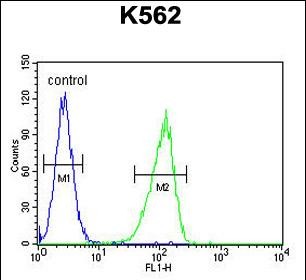CRFR1 Antibody (Q103)
Affinity Purified Rabbit Polyclonal Antibody (Pab)
- 产品详情
- 实验流程
- 背景知识
Application
| WB, FC, E |
|---|---|
| Primary Accession | P34998 |
| Other Accession | P35353, NP_001138618.1, NP_004373.2 |
| Reactivity | Human, Rat |
| Predicted | Rat |
| Host | Rabbit |
| Clonality | Polyclonal |
| Isotype | Rabbit IgG |
| Calculated MW | 47671 Da |
| Antigen Region | 88-119 aa |
| Gene ID | 1394 |
|---|---|
| Other Names | Corticotropin-releasing factor receptor 1, CRF-R-1, CRF-R1, CRFR-1, Corticotropin-releasing hormone receptor 1, CRH-R-1, CRH-R1, CRHR1, CRFR, CRFR1, CRHR |
| Target/Specificity | This CRFR1 antibody is generated from rabbits immunized with a KLH conjugated synthetic peptide between 88-119 amino acids from human CRFR1. |
| Dilution | WB~~1:1000 FC~~1:10~50 E~~Use at an assay dependent concentration. |
| Format | Purified polyclonal antibody supplied in PBS with 0.09% (W/V) sodium azide. This antibody is purified through a protein A column, followed by peptide affinity purification. |
| Storage | Maintain refrigerated at 2-8°C for up to 2 weeks. For long term storage store at -20°C in small aliquots to prevent freeze-thaw cycles. |
| Precautions | CRFR1 Antibody (Q103) is for research use only and not for use in diagnostic or therapeutic procedures. |
| Name | CRHR1 (HGNC:2357) |
|---|---|
| Function | G-protein coupled receptor for CRH (corticotropin-releasing factor) and UCN (urocortin). Has high affinity for CRH and UCN. Ligand binding causes a conformation change that triggers signaling via guanine nucleotide-binding proteins (G proteins) and down-stream effectors, such as adenylate cyclase. Promotes the activation of adenylate cyclase, leading to increased intracellular cAMP levels. Inhibits the activity of the calcium channel CACNA1H. Required for normal embryonic development of the adrenal gland and for normal hormonal responses to stress. Plays a role in the response to anxiogenic stimuli. |
| Cellular Location | Cell membrane; Multi-pass membrane protein. Endosome. Note=Agonist-binding promotes endocytosis |
| Tissue Location | Predominantly expressed in the cerebellum, pituitary, cerebral cortex and olfactory lobe |
For Research Use Only. Not For Use In Diagnostic Procedures.
Provided below are standard protocols that you may find useful for product applications.
BACKGROUND
This gene encodes a G-protein coupled receptor that binds neuropeptides of the corticotropin releasing hormone family that are major regulators of the hypothalamic-pituitary-adrenal pathway. The encoded protein is essential for the activation of signal transduction pathways that regulate diverse physiological processes including stress, reproduction, immune response and obesity. Alternative splicing results in multiple transcript variants.
REFERENCES
Karteris, E., et al. Endocrinology 151(10):4959-4968(2010)
Romero, R., et al. Am. J. Obstet. Gynecol. 203 (4), 361 (2010) :
Bailey, S.D., et al. Diabetes Care 33(10):2250-2253(2010)
Ruano, G., et al. Pharmacogenomics 11(7):959-971(2010)
Hillhouse, E.W., et al. Endocr. Rev. 27(3):260-286(2006)
终于等到您。ABCEPTA(百远生物)抗体产品。
点击下方“我要评价 ”按钮提交您的反馈信息,您的反馈和评价是我们最宝贵的财富之一,
我们将在1-3个工作日内处理您的反馈信息。
如有疑问,联系:0512-88856768 tech-china@abcepta.com.























 癌症的基本特征包括细胞增殖、血管生成、迁移、凋亡逃避机制和细胞永生等。找到癌症发生过程中这些通路的关键标记物和对应的抗体用于检测至关重要。
癌症的基本特征包括细胞增殖、血管生成、迁移、凋亡逃避机制和细胞永生等。找到癌症发生过程中这些通路的关键标记物和对应的抗体用于检测至关重要。 为您推荐一个泛素化位点预测神器——泛素化分析工具,可以为您的蛋白的泛素化位点作出预测和评分。
为您推荐一个泛素化位点预测神器——泛素化分析工具,可以为您的蛋白的泛素化位点作出预测和评分。 细胞自噬受体图形绘图工具为你的蛋白的细胞受体结合位点作出预测和评分,识别结合到自噬通路中的蛋白是非常重要的,便于让我们理解自噬在正常生理、病理过程中的作用,如发育、细胞分化、神经退化性疾病、压力条件下、感染和癌症。
细胞自噬受体图形绘图工具为你的蛋白的细胞受体结合位点作出预测和评分,识别结合到自噬通路中的蛋白是非常重要的,便于让我们理解自噬在正常生理、病理过程中的作用,如发育、细胞分化、神经退化性疾病、压力条件下、感染和癌症。







